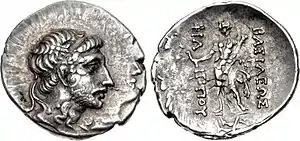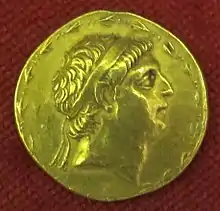Fourth Macedonian War
The Fourth Macedonian War (150 BC to 148 BC) was fought between the Roman Republic and a Macedonian uprising led by the Macedonian pretender to the throne, Andriscus. Pretending to be a descendant of the former ruling dynasty of Macedon, the Antigonid dynasty which had been deposed by the Romans after the Third Macedonian War in 168 BC, Andriscus sought to re-establish the old Macedonian Kingdom.[1] In the process he destabilised Macedonia and much of the Macedonian world. After some early successes, he was eventually defeated by the Romans at the Second Battle of Pydna in 148 BC, leading to the collapse of the uprising. Two years later, Macedonia became a Roman province.
| Fourth Macedonian War | |||||||||
|---|---|---|---|---|---|---|---|---|---|
| Part of Macedonian Wars | |||||||||
 Coin of Andriscus, the Macedonian pretender who led Macedon in the war | |||||||||
| |||||||||
| Belligerents | |||||||||
|
|
Thracian allies | ||||||||
| Commanders and leaders | |||||||||
|
|
| ||||||||
Background
After the defeat of Antigonid Macedon in the Third Macedonian War, Rome broke up Macedon into four client republics, with trade regulations and financial obligations to Rome, including handing over control of Macedon's rich gold and silver mines to the Romans and forbidding the Macedonians from working them, deporting the previous ruling elites to Rome and not being allowed to have any central governing body. However, they left the region ungarrisoned; defense was delegated to local allies.[2]
Andriscus claims the throne

This state of affairs continued until 150 BC, when Andriscus, a fuller from Aeolis, claimed to be a son of the last Antigonid king, Perseus of Macedon. He travelled to Syria to request help from the Seleucid monarch, Demetrius I Soter.[3] However, the king decided to cooperate with the Romans and arrested Andriscus, handing him over to the Romans, who, according to Cassius Dio, held him "in general contempt" due to his ordinary nature and transparently false claim.[4]
Owing to this, he was soon released, and returned to Europe to seek help from the Thracians. Here, he finally secured allies, and organized a coalition of Thracians and anti-Roman elements. From these, he raised an army for claiming the Macedonian throne.[5]
Course of the war
With this force, Andriscus invaded Macedonia and successfully conquered it, after which he launched an invasion of Thessaly, overrunning significant portions of that territory as well.[6]
The Romans seem to have been surprised at this turn of events; Polybius refers to his enthronement and victories as follows:
But as to the Pseudo-Philip, the report at first appeared quite beneath consideration. A Philip suddenly appears in Macedonia, as though he had dropped from the skies, in contempt of Macedonians and Romans alike, without having the least reasonable pretext for his claim, as every one knew that the real Philip had died in Alba in Italy two years after Perseus himself. But when, three or four months afterwards, a report arrived that he had conquered the Macedonians in a battle in the territory of the Odomanti beyond the Strymon, some believed it, but the majority were still incredulous. But presently, when news came that he had conquered the Macedonians in a battle on this side of the Strymon, and was master of all Macedonia; and when letters and envoys came from the Thessalians to the Achaeans imploring help, as though the danger were now affecting Thessaly, it seemed an astonishing and inexplicable event; for there was nothing to give it the air of probability, or to supply a rational explanation of it.
— Polybius, The Histories, book 37, [7]
To get a clear understanding of events, the Romans first sent Scipio Nasica Corculum on a fact-finding mission, and to try and settle matters without needing to resort to military force.[8] When it became clear that Andriscus was a threat, they appointed a praetor, Publius Juventius Thalna, to command a legion and reconquer Macedon by military force. However, Andriscus successfully attacked and defeated the praetor near the borders of Macedon, killing him in battle and nearly annihilating the Roman army. He then declared himself King Philip VI of Macedonia and re-established the Macedonian monarchy.[3][9]
Andriscus then launched another invasion of Thessaly, successfully conquering it.[3] Alarmed, the Romans sent another army of two legions under another praetor, Quintus Caecilius Metellus Macedonicus, to defeat him. Metellus received the assistance of the fleet of Attalus II Philadelphus of Pergamon, threatening the Macedonian coastal districts and forcing Andriscus to take up a defensive position near the town of Pydna, where the Roman commander decided to engage him in battle.[9]
Second Battle of Pydna
Not many details survive about the battle, but it seems that Andriscus initially had the upper hand, with his cavalry gaining success. Seeing this, he sent away some of his forces to continue his campaign in Thessaly, possibly due to supply issues or to threaten the Roman rear, or due to overconfidence. Metellus seized this opportunity to attack in full strength, routing the Macedonians. Dio indicates that some of the troops may have defected to the Romans.[10][11]
End of the war

The battle shattered Andriscus' army and broke the Macedonian war effort. He tried to raise another army in Thrace, but after further defeats, was handed over by a Thracian named Byzes to the Romans, who soon consolidated their hold on Macedon.[12]
Dio mentions "one Alexander" who now declared himself to be a son of Perseus and occupied the basin of the Nestus River, but was quickly defeated by Metellus and forced to flee into Dardania.[13] Zonaras affirms this, but Livy and Eutropius do not mention him and instead only refer to an Alter pseudophilippus (second pseudo-Philip), in 143-142 BC, and that he was defeated by a quaestor, Lucius Temellius.[14][15]
Metellus celebrated a triumph and gained the agnomen Macedonicus. Andriscus, after being paraded in this triumph, was executed.[3]
Aftermath
Soon afterwards, the Achaean League in 146 BC mobilized for a new war against the Roman Republic. This is sometimes referred to as the Achaean War, and was noted for its short duration and its timing right after the fall of Macedonia. Until this time, Rome had only campaigned in Greece in order to fight Macedonian forces, allies or clients. Rome's military supremacy was well established, having defeated Macedonia and its vaunted Phalanx already on three occasions, and defeating superior numbers against the Seleucids in Asia.[16] The Achaean leaders almost certainly knew that this declaration of war against Rome was hopeless, as Rome had triumphed against far stronger and larger opponents, the Roman legion having proved its supremacy over the Macedonian phalanx.[17]
Polybius blames the demagogues of the cities of the league for inspiring the population into a suicidal war. Hellenistic stirrings and the idea of triumphing against superior odds motivated the league into this rash decision. The Achaean League was swiftly defeated, and, as an object lesson, Rome utterly destroyed the city of Corinth in 146 BC, the same year that Carthage was destroyed.[18] After nearly a century of constant crisis management in the Greek world, which always led back to internal instability and war when Rome pulled out, the Senate decided to establish the Roman province of Macedonia, covering all of mainland Greece and establishing a permanent Roman presence in the region, though a few territories like Athens and Sparta retained self-government and partial autonomy. More than a century later, Augustus would establish Achaea as a separate province.[19]
References
- Goldsworthy, In the Name of Rome, p. 218
- Livy, Book XLV
- Chisholm 1911.
- Dio, XXI.71
- Dio, XXI.71
- Dio, XXI.71
- Polybius, 37.2
- Dio, XXI.71
- Morgan 1969, p. 423.
- Dio, XXI.71
- Morgan 1969, p. 426.
- Dio, XXI.71
- Dio, XXI.71
- Livy, Periochae 53.2
- Morgan 1969, pp. 430-431.
- History of Rome – The republic, Isaac Asimov.
- Adrian Goldsworthy (2004), In the Name of Rome, p. 218
- History of Rome – The republic, Isaac Asimov.
- Pausanias, 7.16-7.17
| Library resources about Fourth Macedonian War |
Sources
- Cassius Dio, XXI. 71.
- Velleius Paterculus i. 11
- Livy, Book XLV and Epitomes 49, 50, 52
Attribution
 This article incorporates text from a publication now in the public domain: Chisholm, Hugh, ed. (1911). "Andriscus". Encyclopædia Britannica. 1 (11th ed.). Cambridge University Press. p. 975.
This article incorporates text from a publication now in the public domain: Chisholm, Hugh, ed. (1911). "Andriscus". Encyclopædia Britannica. 1 (11th ed.). Cambridge University Press. p. 975.- Morgan, M. Gwyn (1969). "Metellus Macedonicus and the Province Macedonia". Historia: Zeitschrift für Alte Geschichte. 18 (4): 422–446. JSTOR 4435094.
External links
Further reading
- Gabrielsen, Vincent, and John Lund, eds. 2007. The Black Sea in Antiquity: Regional and interregional economic exchanges. Aarhus, Denmark: Aarhus University Press.
- Sherwin-White, Adrian N. 1984. Roman foreign policy in the East 168 B.C. to A.D. 1. London: Duckworth.